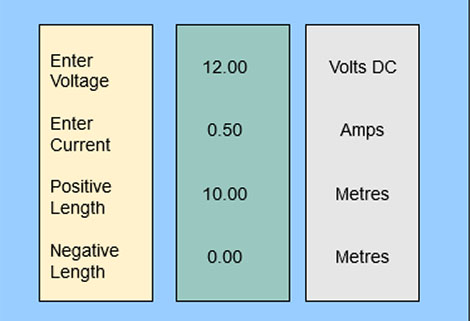how to wire a narrowboat - part 2
calculating volt-drop and cable selection
Now the next thing to do is calculate the Volt-drop for each route through each light.
In the first edition I did not pay sufficient attention to calculating volt-drop and cable selection. So I am going to start from the basic drawing, labelled with measurements of various cables. For this first example I am going to use the rear deck lights circuit.
 The first thing is that for running electrical cables for anything around the boat we should use nothing smaller that 1.5mmsq. This is because this is the minimum size that will stand up to the stresses of being strung around a boat that vibrates.
The first thing is that for running electrical cables for anything around the boat we should use nothing smaller that 1.5mmsq. This is because this is the minimum size that will stand up to the stresses of being strung around a boat that vibrates.
We need to aim for as near as we can for a volt-drop from the batteries to the items on the end of the cables of less than 5%. It is relatively easy to get the volt-drop from the battery to the Fuse-board down into the area of 2%, and the volt-drop from the fuse-board to the items down to less than 3%.
First we need to calculate the volt-drop for the circuit against the various cable sizes we could use. We need three pieces of information to calculate the volt-drop
The voltage of the system; it is 12V for this particular boat.
The second is the current the amps (A). In this case we have two lights each with a rating of 3 Watts (3W x 2 = 6W). But we need to know the current, the amps (A) – Watts/Volts = Amps (W/V = A). We have both of those the Volts 12V and the Watts is 6W. 6/12 = 0.5A
The third is the total length of the cable run from the voltage source positive back to the negative voltage source. We have this on the drawing because we measured it on the scaled boat outline if we start at the positive busbar and add the lengths travelling to the negative busbar - 3+4+3 = 10 metres.
Now we can either do this plugging the values into the standard formulae for volt-drop umpteen times or we can use the volt-drop calculator in the files section of the group, which gives the answer for all the standard cable sizes in one go. It is downloadable from 12 Volt Boating Group
Or you can use this formulae umpteen times
The voltage drop (V) at the load, in volts, can be calculated using the following formula:
Volt-drop = 0,0164 ×I ×L/S
Where
S is the conductor cross-sectional area, in millimetres squared
l is the load current, in amperes.
L is the length, in metres, of conductor from the positive power source to the electrical device and back to the negative source connection.
Below I have plugged the values into the 12 Volts Boating Group volt-drop calculator.



There are several cables that we could use;
1.5mmsq, which has a volt-drop of 0.06V/0.53%
2mmsq, which has a volt-drop of 0.05V/0.39%
2.5mmsq, which has a volt-drop of 0.04V/0.32%
3mmsq, which has a volt-drop of 0.03V/0.25%
We need to look ahead to what will be the heaviest circuit on our lighting circuit in terms of percentage loss. This could be caused by it being high current or just the length of the cable runs. In this case it is the passageway lights because of the length of cables used to give the ability to allow the passageway lights to be switched off at the bow or stern. If we can use the same size cable for the majority of the wiring we will be able to buy reels of that cable that is cheaper than buying by the metre.

Passageway lighting circuits
This is where you, I hope, learn the simple way to calculate the combined volt-drop of several circuits that come together as one on the way to the batteries.
Looking at the circuits they all come together at the switch 2W2 so we can calculate their individual volt-drops and the volt-drop from switch 2W2 to the fuse board.
The currents of each of the circuits are 0.75A, 1.0A and 0.5A, and I have calculated their individual volt drops at 2.06%, 2.98% and 0.90% and the current for switch 2W2 to the fuse board etc is the total of all the circuits 2.25A and the Volt-drop is 2.25% using 3mmsq cable.
Each of the three circuits will take part of the 2W2 switch circuit losses proportional to each circuit's current. So first circuit has a current of 0.75A divide by the total current of 2.25A is 0.333, so the proportion of the Switch 2W2 percentage loss 2.25% x 0.333 gives us the percentage of the Switch 2W2 loss that belongs to the first circuit equals 0.75% which needs adding to circuit one loss of 2.06% which equals 2.81%. We repeat that for each circuit and by using 3mmsq cable for the switch 2W2 to 2W1 and onward to the fuse-board wiring and 2mmsq for the rest of the circuits. I hope that all makes sense
Now you need to work your way through all the drawings working out volt-drop and cable size etc.

Lighting 1 circuit complete

Lighting 2 circuit complete

Tungsten/Halogen Headlight completed

LED Headlight completed

Passageway lighting circuit complete
Gradually you build a set of drawings for the lighting that has all the information on them. From there you can workout the shopping list for cable etc and install the lighting on the boat.

